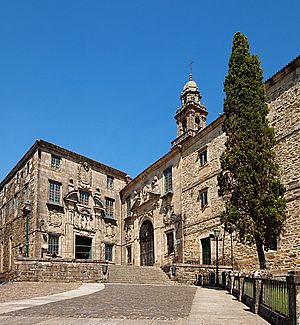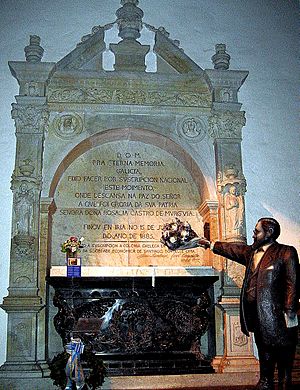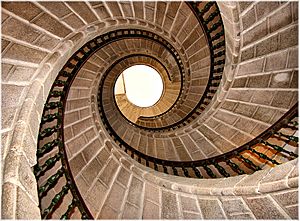Convent of San Domingos de Bonaval facts for kids
Quick facts for kids Convent of San Domingos de Bonaval |
|
|---|---|

Main facade of the convent (right) and the Museum of the Galician people (left)
|
|
| Religion | |
| Patron | Saint Dominic |
| Status | Museum and pantheon |
| Location | |
| Location | Santiago de Compostela, Galicia, Spain |
| Architecture | |
| Architectural style | Gothic, Baroque, Neoclassical |
The Convent of St Dominic (in Galician: Convento de San Domingos de Bonaval) is an old monastery in Santiago de Compostela, Galicia, Spain. It was once home to Dominican monks. This amazing building shows off different styles of architecture. A famous architect named Domingo de Andrade helped design parts of it. In 1912, it was officially named a national monument.
Contents
Where is the Convent of St Dominic?
The convent is in Santiago de Compostela. It sits just outside the old city walls. You can find it on the slopes of Mount Almáciga. It is also close to Porta do Camiño. This was one of the main gates for pilgrims entering the city long ago.
A Look at the Convent's History
How the Convent Started
The convent was founded by Saint Dominic in the early 1200s. Saint Dominic himself visited Santiago in 1219. The oldest paper mentioning the convent is from 1228. Back then, it was called Santa Maria. Later, around the 1400s, it became known as Santo Domingo. The powerful Altamira family also became its protectors.
Rebuilding the Convent
In 1695, work began to rebuild the convent. The old building was not in good shape. Domingo de Andrade, a well-known architect, led this project. Archbishop Antonio de Monroy supported the work. Most of what you see today is thanks to these big changes. The archbishop was in charge from 1685 to 1715. Like many monasteries in Spain, it closed in the 1800s. This happened during a time when the government took over church properties.
What to See at the Convent
The Church Building
The church was built in Gothic and Renaissance styles. It is not used for church services anymore. Instead, it holds the Pantheon of Illustrious Galicians. It is also a place where concerts are held. The church has tall, open spaces. It was designed so that services focused on the pulpit. This was different from older churches. Important noble families, like the Moscoso and Castro families, were buried here. This was allowed by Pope Innocent IV.
Famous People's Pantheon
Inside the monastery church, there is a special chapel. It is called the Pantheon of Illustrious Galicians. This is where many important Galician people are buried. These include famous writers like Rosalia de Castro and Ramón Cabanillas. The intellectual Domingo Fontan is also buried here. So is the sculptor Francisco Asorey.
The last person buried here was Alfonso Daniel Rodríguez Castelao. He was a politician, writer, and artist. Many consider him the father of modern Galician identity. His remains were moved here in 1984.
The Main Entrance
The main entrance is topped by the coat of arms of the Counts of Altamira. They were the convent's patrons. The entrance is not very big. It has three main parts, both across and up and down. The doorway has two pillars decorated with fruit. These are a common design by Andrade. Above the door is a curved top with a statue of Santo Domingo. On each side of the door are rectangular windows. You can still read an old message above the doors. It remembers Archbishop Monroy, who ordered the building work.
The Amazing Triple Staircase
One of the most amazing parts inside is the triple helical staircase. It was built in the 1600s and 1700s. This unique staircase was also designed by Domingo de Andrade. It has three separate ramps. Each ramp leads to a different area. Only one of them goes to a viewpoint. The steps are made from single pieces of stone. They fit together without touching the wall or each other. This staircase was repaired by Xosé Cerviño Garcia.
The Convent Tower
The tower was also designed by Domingo de Andrade. Archbishop Monroy supported its construction. Its design is similar to the Clock Tower at the Cathedral of Santiago de Compostela. It was finished in the early 1700s.
What is the Convent Used For Today?
Today, the Museo do Pobo Galego (Museum of the Galician People) is located here. There is also a public park within its grounds. The convent is right next to the CGAC. This is the Centro Galego de Arte Contemporanea, or the Galicia Contemporary Art Centre.
See also
 In Spanish: Convento de Santo Domingo de Bonaval para niños
In Spanish: Convento de Santo Domingo de Bonaval para niños



